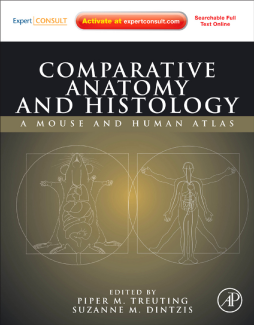
BOOK
Comparative Anatomy and Histology
Piper M. Treuting | Suzanne M. Dintzis | Denny Liggitt | Charles W. Frevert
(2011)
Additional Information
Book Details
Abstract
Comparative Anatomy and Histology: A Mouse and Human Atlas is aimed at the new mouse investigator as well as medical and veterinary pathologists who need to expand their knowledge base into comparative anatomy and histology. It guides the reader through normal mouse anatomy and histology using direct comparison to the human. The side by side comparison of mouse and human tissues highlight the unique biology of the mouse, which has great impact on the validation of mouse models of human disease.
- Offers the first comprehensive source for comparing human and mouse anatomy and histology through over 600 full-color images, in one reference work
- Experts from both human and veterinary fields take readers through each organ system in a side-by-side comparative approach to anatomy and histology - human Netter anatomy images along with Netter-style mouse images
- Enables human and veterinary pathologists to examine tissue samples with greater accuracy and confidence
- Teaches biomedical researchers to examine the histologic changes in their mutant mice
"Long overdue, the editors have assembled a vast array of knowledge, protocols, lab lore and practical advice in a concise, well illustrated, and easily accessible volume of practical comparative anatomy of the mouse and human. Students learning anatomy and histology at a practical level by the necessity of the mouse experiments in their laboratories will love this resource. I would recommend that any investigator asking a student, fellow or technician to do mouse necropsy and dissection should provide a copy of this book (and ideally further training in one of the nationally available or online courses in mouse pathology). Even for veterinary pathologists who are more familiar with comparative anatomy, the focus in their training is rarely on the mouse and never on the human. The strict inclusion of just these two species provides an important and practical simplification of critical issues in using the mouse to model human disease. This book is long overdue and much needed in any of the thousands of laboratories performing research with mice."
--Alexander D. Borowsky, M.D., D.A.B.P., Associate Professor of Pathology and Laboratory Medicine, Center for Comparative Medicine, UC Davis, CA, USA
"Given the importance of the laboratory mouse in safety assessment and risk assessment, this text on the comparative anatomy and histology of the mouse and human represents a unique and highly tangible contribution and essential tool for basic and clinical researchers, drug developers, and toxicologists. The authors of individual chapters provide excellent full color gross and photomicrographic depiction of mouse and human anatomy and histology accompanying a tersely written and comprehensive text dealing with the important anatomical and functional components of each organ system. The figures are clearly labeled with easy to understand legends. Tables detailing similarities and differences in cellular composition for each organ system are provided. Chapters are clearly written and organized for easy access to important comparative features of mouse and human anatomy. As an additional bonus, brief ‘Need-to-Know" snippets of take-away summary points are provided throughout each chapter. Each chapter is followed by a recommended reading list. I highly recommend this book."
--R. R. Maronpot, DVM. MS, MPH. Chief of Laboratory of Experimental Pathology, NIEHS, NIH. (Retired). Maronpot Consulting LLC, Raleigh, NC, USA
"Comparative Anatomy and Histology: A Mouse and Human Atlas is an excellent resource for researchers using mouse models to study human disease. The "need to know" bullets in each chapter are useful for the generalist with extensive detail that will prove useful to those needing more in-depth detail of the cellular structure of mouse and human tissues. The color figures and anatomical drawings are of excellent quality. A very useful feature is contrasting the differences between humans and the mouse. This book will be an excellent resource to investigators in a variety of disciplines."
--Gary A. Boorman, DVM, MS, PhD, Diplomate ACVP, Diplomate ACLAM, Diplomate ABT, Pathologist, Covance Laboratories, Inc., Chantilly, VA, USA
